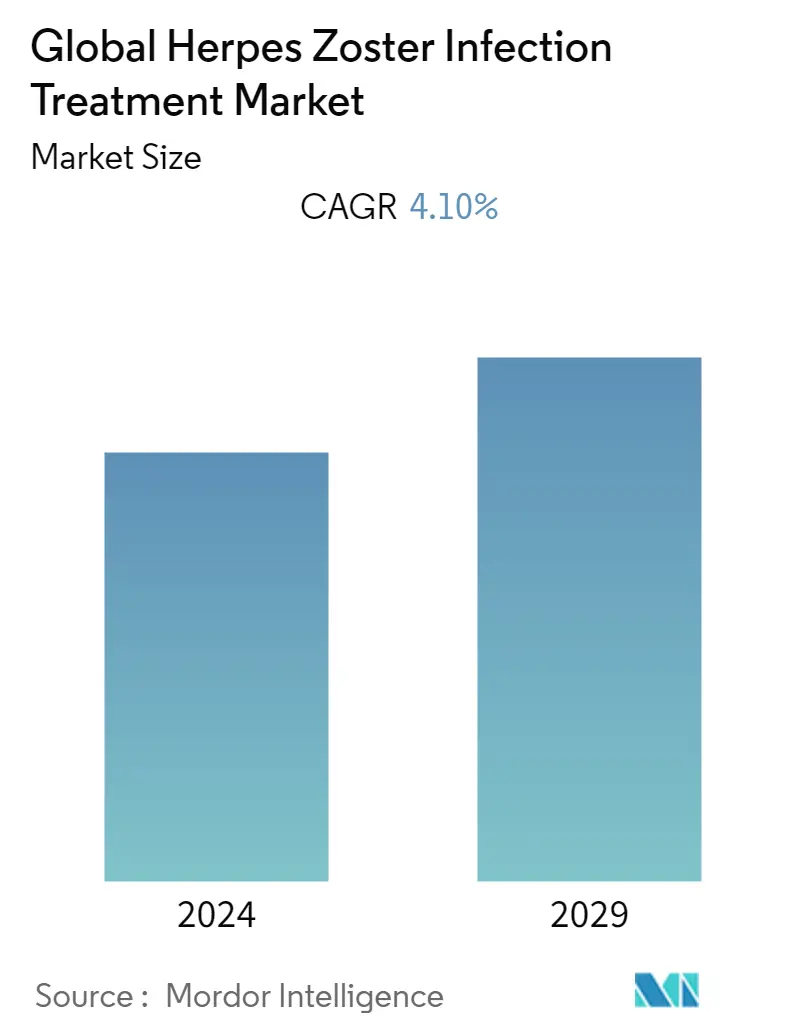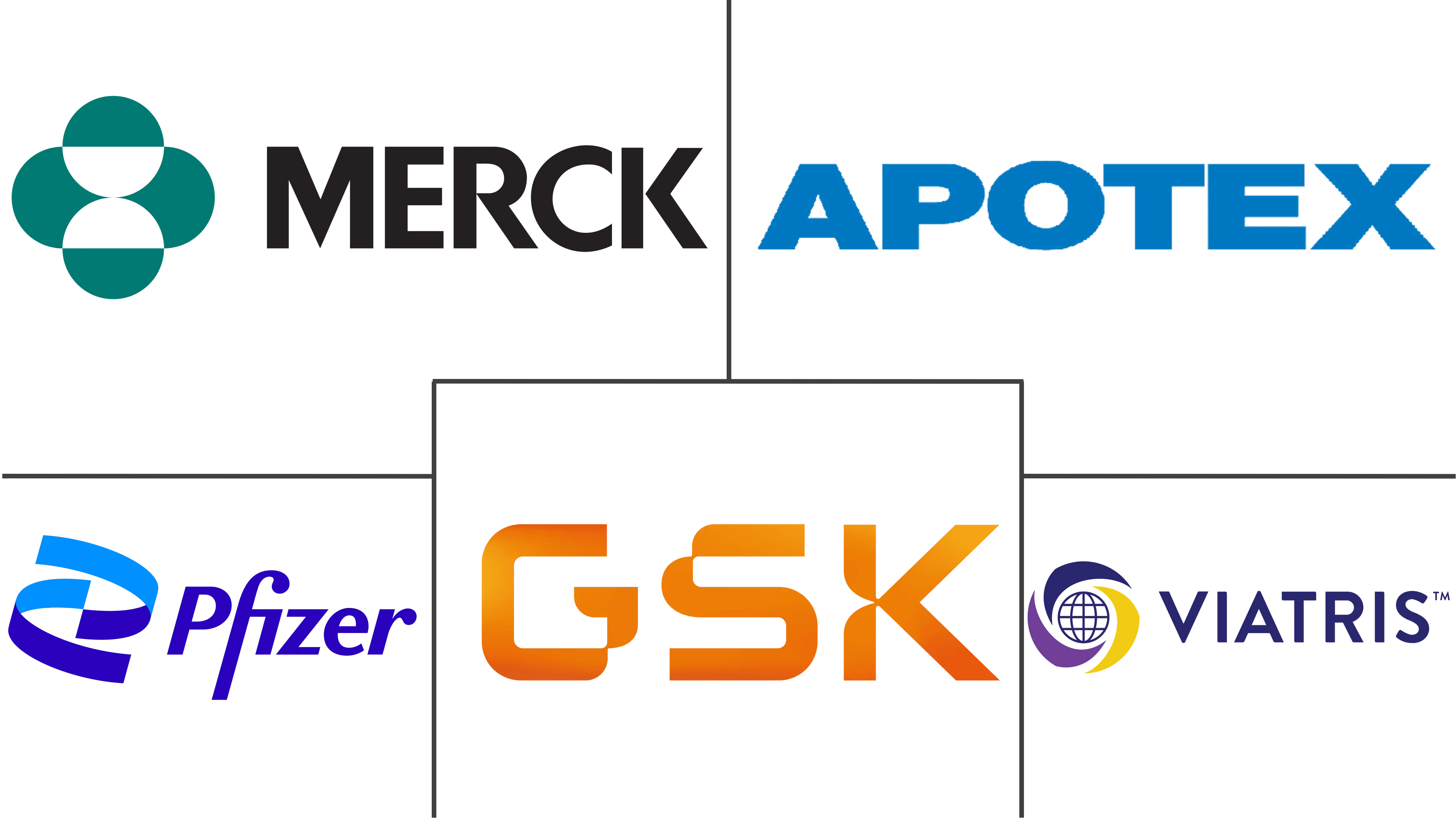Market Size of Global Herpes Zoster Infection Treatment Industry

| Study Period | 2019 - 2029 |
| Base Year For Estimation | 2023 |
| CAGR | 4.10 % |
| Fastest Growing Market | Asia-Pacific |
| Largest Market | North America |
| Market Concentration | Medium |
Major Players
*Disclaimer: Major Players sorted in no particular order |
Need a report that reflects how COVID-19 has impacted this market and its growth?
Herpes Zoster Infection Treatment Market Analysis
During the time frame of the forecast, the herpes zoster infection treatment market is expected to register a CAGR of 4.1%.
COVID-19 had a significant impact on the growth of the market. Herpes zoster infection is caused by the reactivation of the varicella-zoster virus, which can occur in patients who have immunosuppressive diseases or whose cell-mediated immunity declines with age. Coronavirus infection has also been linked to T-cell immunological dysfunction and can result in Herpes zoster reactivation.For instance, as per the study published by PubMed in July 2022 on COVID-19 individuals, varicella-zoster virus reactivation could occur as a result of T-cell malfunction, such as lymphopenia and lymphocyte depletion. Patients with COVID-19 were more likely to reactivate herpes zoster due to the tendency of COVID-19 to establish an immunosuppressive state, related to the functional impairment and the concurrent quantitative drop in T lymphocytes, especially cd4+ T cells, cd8+ T cells, and natural killer cells. Additionally, the COVID-19 pandemic also disrupted the supply chain of antiviral drugs, which had a negative impact on the studied market. For instance, according to an article published by PubMed in May 2022, antiviral drug purchases significantly decreased in developed countries during the early pandemic. Therefore, the COVID-19 pandemic had a pronounced impact on the growth of the market. However, as the pandemic has currently subsided, the studied market is expected to have stable growth during the forecast period of the study.
The key market drivers for the growth of the herpes zoster infection treatment market include the rising geriatric population coupled with the rising incidence of herpes zoster, growing awareness regarding the use of the varicella vaccine, and an increase in immunization programs across the world. Herpes zoster (HZ) has a cumulative incidence rate of 2.9-19.5 cases per 1,000 population and an incidence rate of 5.23-10.9 cases per 1,000 person-years, according to a study published in PubMed in March 2021.Females had higher cumulative incidence and incidence rates than males. Because of weak immune systems, elderly people are more susceptible to herpes zoster. The geriatric population is expected to have a significant impact on the market studied as people over 65 are more susceptible to chronic diseases. For instance, according to the study updated by the NCBI in September 2022, herpes zoster occurs at a rate of 1.2 to 3.4 per 1000 people per year in younger, healthy people, but at a rate of 3.9 to 11.8 per 1000 people per year in patients over 65. Hence, herpes zoster is more prevalent in the aging population.
Moreover, the growing geriatric population is expected to positively impact market growth. For instance, according to the World Population Prospect 2022, the global population of people aged 65 and older is estimated at 77 million in 2022 and is expected to reach 1.6 billion by 2050. As the geriatric population is more susceptible to herpes zoster, the increasing number of cases is expected to boost market growth over the forecast period.
Additionally, the increasing coverage of the herpes zoster vaccine, or shingles vaccine, is also expected to boost market growth. For example, according to data updated by the United Kingdom Government in November 2022, 31.2% of patients aged 70 in the United Kingdom received the shingles vaccine during 2021-2022, while 74.9% of patients aged 76 received the vaccine during the same time period.
Additionally, the market is also driven by increasing awareness about the use of varicella vaccinations and market players adopting various strategies such as product launches, mergers and acquisitions, and fundraising for research and development activity. For instance, in February 2021, Dr. Florian Full of the Institute of Clinical and Molecular Virology at Universitätsklinkum Erlangen at Friedrich-Alexander-Universität (FAU) received EUR 2.34 million in funding from the Federal Ministry of Education and Research (BMBF) for the development of a new herpes virus medication. Such instances may positively impact market growth over the forecast period.
Thus, owing to the aforementioned factors such as the high prevalence of herpes zoster, the growing geriatric population, increasing awareness about the use of varicella vaccinations, and market players adopting various strategies such as product launches, mergers and acquisitions, and fundraising for research and development activity, the market is expected to project growth over the forecast period. However, the high cost of the vaccine is likely to hinder market growth over the coming years.
